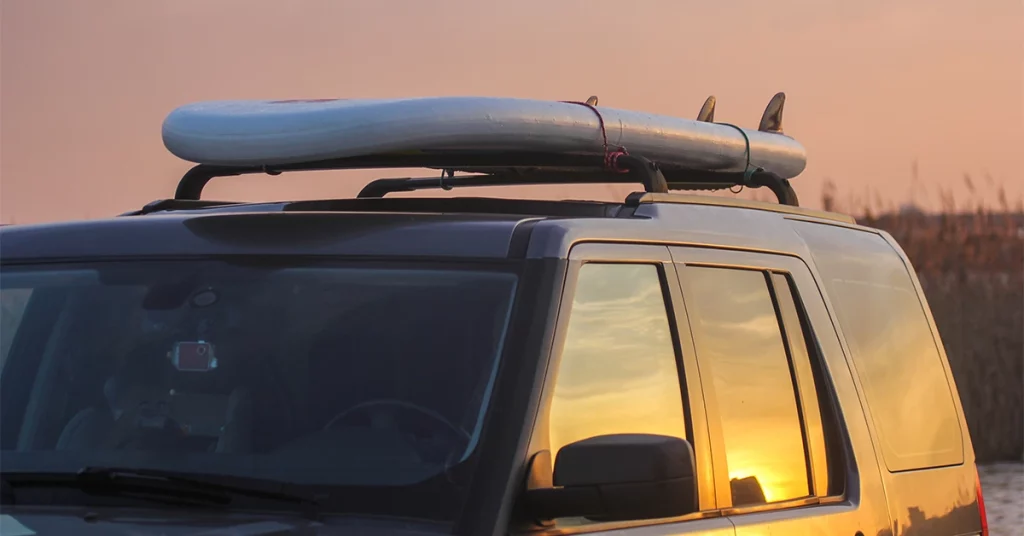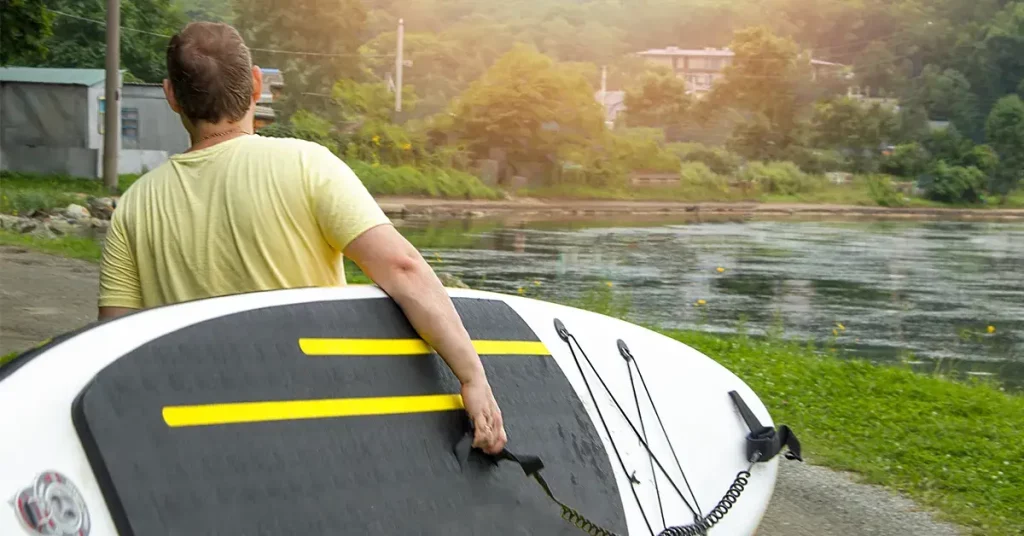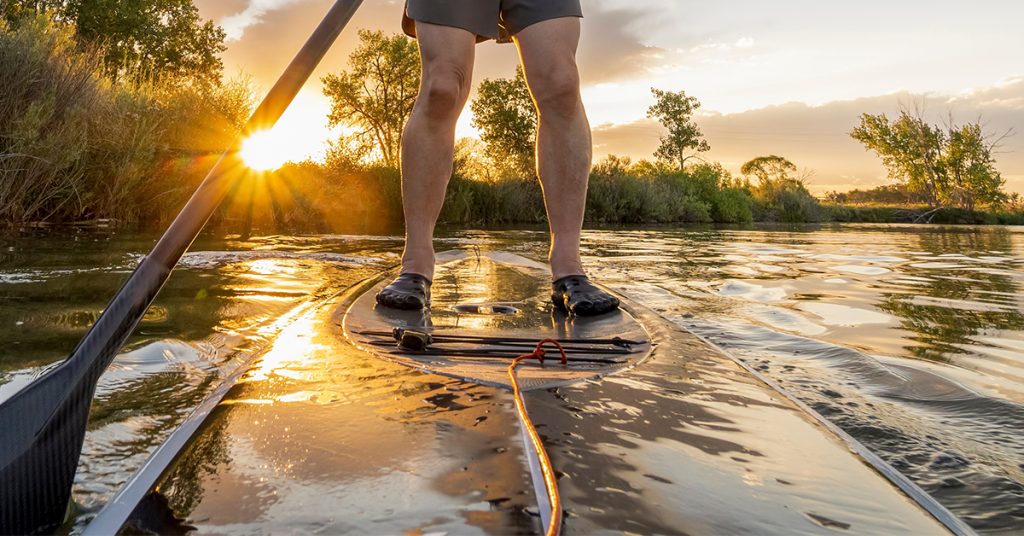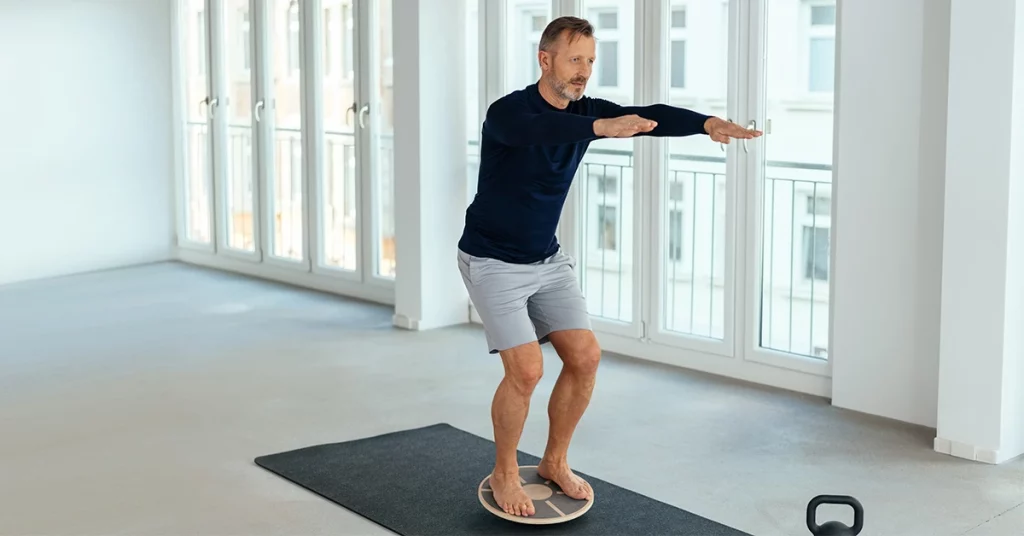You finally purchased the Stand Up Paddle Board (SUP) and can’t wait to test it on crystal blue water. Now, it’s time to learn how to strap a paddle board to a roof rack the right way so you can go explore those waters.
Transporting your rigid stand up paddle board easily and securely on your vehicle’s roof with ratchet straps and the rack system is the best way to go.
We’ll talk about the additional gear you’ll need to mount the SUP on your roof rack and get you to familiarize yourself with your board.
Finally, we’ll talk about the best way to lift the board onto the rack, slide the paddle upward without damaging your car, and fasten the cam straps securely to the board on the roof rack.
How To Transport a Paddle Board To Your Vehicle

Designers of SUPs have thought of everything. There’s even a convenient handle in the middle of your board deck.
Here’s a quick tutorial on lifting paddle boards onto roof racks protected with foam blocks or padding for paddle board transport:
Part 1
- To hoist the board under your armpit, stand it against a wall on its side, handle facing out, nose facing forward.
- Bend to a squat, reach for the carry handle and walk to your vehicle.
Part 2
- Plan ahead and use caution. You don’t want to injure your back or ding your car.
- Bend but keep your back straight and lift with the power of your knees.
- Gusts of wind force may unbalance you once you pick up the board. Point the nose of the board into the wind (not the flat, wide side).
- Invest in a SUP cart to save your energy ($100).
- Tuck the stand-up paddle under the arm carrying the board and use your free hand to maneuver obstacles.
- Inflatable paddle boards come with a convenient board bag you can store in the trunk, or deposit onto the roof rack with tie down straps.
Caveat:
Of course, if you bought an inflatable board, you can just grab the bag handles and haul it to the car. That is an excellent advantage.
Different Equipment Needed To Strap Your Paddle Board To The Roof

Your life is simpler if you own a vehicle with an enclosed carrier like a truck or van. The board should lay flat in the bed and still be able to shut the truck’s tailgate.
You’ll still need tie downs for extra security and prevent it from becoming airborne.
People who drive compact vehicles like SUVs, station wagons, or sedans with limited interior space, need to mount the board on the roof.
Essential accessories fasten your paddle board to your roof rack easily.
Before Making Rash Purchasing Decision think about These Challenges:
- Are soft racks as secure as hard racks? Yes, if done correctly.
- Is having hard racks better for multiple boards and your largest board? Yes.
- Will straps feeding through the car window cause leaking in rainy conditions? Possibly.
- Will I be transporting more than one board in the hot sun? Only you know the answer.
Mounting Equipment Options:
Cross bars are versatile and come in hard fit or soft fit. Cross bars run front to back and may be a factory install on your vehicle. If they’re not, consider tool-free mounting rack options for your car’s roof rack.
Rack/Padding rack systems are SUP industry systems. These gems only transport paddle boards.
Cam Straps (Cam Buckle Straps) are tie down straps that utilize physical strength without a mechanism like a ratchet.
The minimum length requirement for one board is usually two straps 12 feet in length.
Using two cam straps is a popular method. The strapping material is sensitive to the product they’re tying down and prevents damage.
Using a cam strap to secure fragile objects like your board bags or inflatable paddle board makes over-tightening difficult.
Bow and Stern lines employ a tightening mechanism. They sometimes have an S-hook on one end and are non-stretch, water-resistant rope material.
Typically you’ll need two lengths of strapping for each end.
Ratchet straps may be overkill for transporting your boards but are ideal for heavier objects like kayaks and canoes.
Basic Step-by-Step Guide Of How To Strap The Paddle Board To The Roof

Now that you maneuvered one or several boards to your car, what’s next?
The last thing you want to happen is for your hard boards to slip and scratch or dent your vehicle.
Ideally, if you can find an extra set of hands to help you lift your rigid boards, you’ll save your back and wear and tear on your vehicle.
However, no one lives in a perfect world. With practice, spur-of-the-moment getaways and loading your stand-up paddle board becomes a snap.
Here’s How To Lift When Solo (onto shorter, low-to-the-ground vehicles like sedans and wagons):
- Plan your lift. Position the board carefully against the car (or nearby wall or fence) and face the deck/stand-on side toward you. Ensure the fin will swing toward the front of the vehicle once you lift it.
- Grasp the handle and balance the board (upper edge) with your free hand.
- As you lift the lip of the board onto your knee (slight squat), switch the hand from the handle to the opposite edge of your other hand. This hand position should allow you to have a firm grip and good balance.
- Lift with your knees as you move the board overhead (deckside is down).
- Carefully slide the board (fins up) into position on the rack/padding of the roof rack.
Here’s How To Hoist a Board Onto a Tall Vehicle (like SUVs, or minivans):
- Lean your board (deck down/ fins facing up) against the back end of your vehicle.
- Squat (protect your spine) and lift the tail end of your board onto the lip of the car.
- Keep pushing the board in a slow-motion until it lines up with your vehicle and roof rack position (fin side up)
Other Suggestions For Safe Transport:
- If your paddle board doesn’t fit inside your car, invest in specific paddle board holders that work with your roof rack.
- For multiple board transport, load the longest board first. Add a layer of protective padding between the first and second board to prevent scratch damage.
- For loading boards in truck beds, use padding to avoid damage while in transport. The constant motion of your truck moving may rub against the surface of your board. Secure a red flag to alert drivers closing in your vehicle.
Step-by-Step Paddle Board Tying Guide

If you invested in a permanent SUP rack, all that’s required is a quick cinching of the attached straps on a secure attachment point, and you’re on your way even with multiple paddle boards.
Here’s a Quick How-to (For Those Using Foam Blocks or Padding and Cam Straps)
- Once the paddle board is parallel with your vehicle, wiggle it into position until the widest point of your board rests between the crossbars of your rack.
- Place the cam strap buckle near the lip of your board (close to one of the crossbars) and unfurl the strap by tossing it across. (Repeat each step with the second strap.)
- Move to the other side. Grasp the loose ends and feed them under the crossbar (inside, where the crossbar attaches to the roof to prevent slippage). Toss it back over the board to the starting side.
- Return to the starting point, loop the strap under the crossbar, and feed the first strap through the cam buckles cinching firmly (again strap needs to be on the inside of the crossbar mount).
- Tighten the strap underneath without over-tightening(avoid cutting into the board).
- Secure any loose ends from the strap and fasten them to the cross bar. You’ll prevent loosening and wind flapping at high speeds by securing the tail ends with a tied end.
- Test your board movement by giving the boards a good tug and ensuring they’re secure.
Using Bow and Stern Straps For Longer Boards and Added Security

Oversized SUPs and high wind speeds can wreak havoc on your drive, boards, and safety while traveling to your destination.
For additional security under those conditions consider using ratcheting bow and stern lines (front and back).
- Adjust your board(s) into position. Attach the ratchet to a sturdy point of your paddle board (leash loop).
- Now walk the other end of the strap to a solid anchor point of your vehicle. (Install a hood loop strap.) Find the sturdiest parts of your car at the back and front. (Never attach plastic parts.)
- Tug the free end of the strap until tight but don’t apply extensive force.
- Wrap the extra portion of strapping around a secure fixture like the rack arms.
- Repeat on the other end (front to back) and fasten loose ends.
- If your SUP doesn’t have a tow line hook, invest in suction cup anchors.
Additional Tips For Securing A Paddle Board

Tying and securing an SUP takes practice and the right accessories. Here are a few extra tips from experts.
- Add a twist to the strap line; it will lessen wind flap.
- Don’t use fancy knots; you don’t need them.
- Use a ladder to save your back, board, and vehicle.
- Locking cam straps prevents theft.
- If you’re using water-resistant rope, tie it with a trucker’s hitch knot
That’s it– You’re ready!
Once you’ve learned how to strap a paddle board to the roof rack, the last thing you need to do is get out there and enjoy nature and every experience that comes your way on your SUP!




